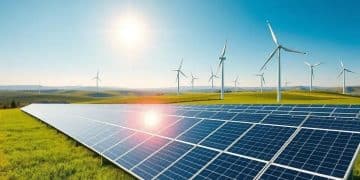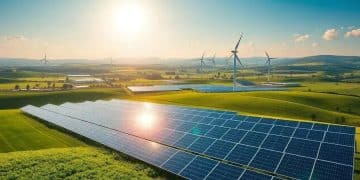Insights on data center efficiency news: Why it matters
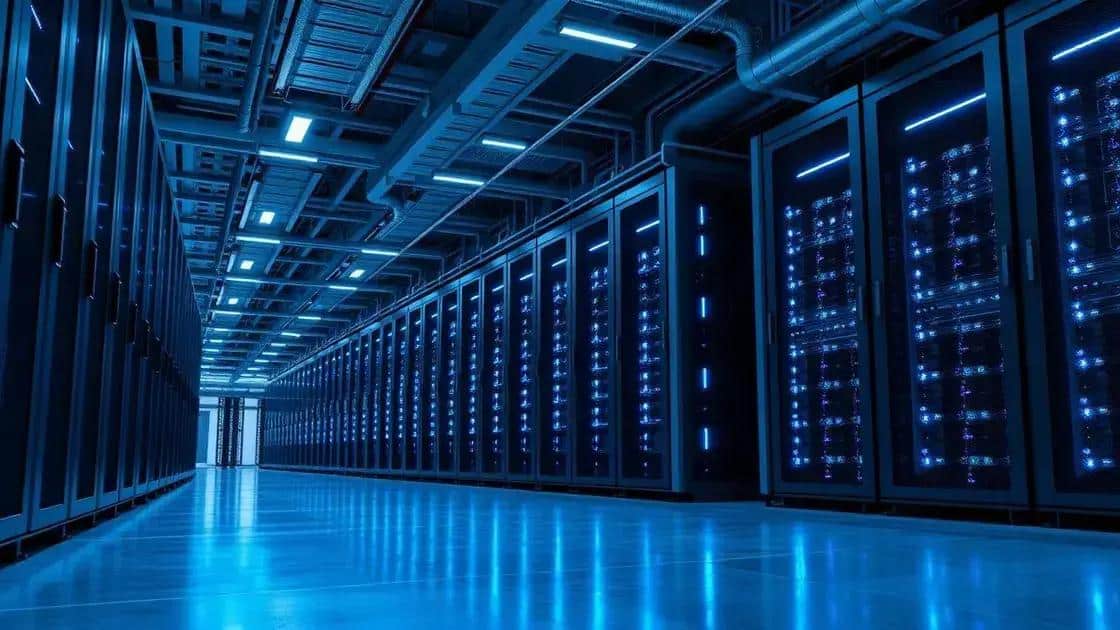
Optimizing data center efficiency involves regular maintenance, effective cooling management, and energy monitoring to reduce costs and enhance performance, addressing increasing demands for sustainable IT operations.
Insights on data center efficiency news can significantly impact how organizations manage their resources. Have you ever wondered how efficiency innovations might improve your operations? Let’s dive into the latest trends.
Understanding data center efficiency metrics
Understanding data center efficiency metrics is crucial for organizations seeking to optimize their operations. These metrics help to assess and improve overall performance by providing insights into various aspects of the data center.
Key Efficiency Metrics
Several key metrics can be monitored to gauge the efficiency of data centers:
- PUE (Power Usage Effectiveness): This measures the total building energy usage divided by the energy used for IT equipment.
- RUE (Resource Usage Effectiveness): Similar to PUE, RUE focuses on the usage of resources like CPUs and memory.
- Watt per VM: This indicates the energy consumption per virtual machine, helping to understand efficiency at a granular level.
By keeping track of these metrics, organizations can identify areas that need improvement. For instance, if the PUE is too high, it signals that the data center might be using excessive energy for cooling or other non-IT systems.
Importance of Monitoring
Monitoring these metrics regularly ensures that your data center is running optimally. With advancements in technology, automated solutions can assist in tracking these key performance indicators in real-time.
Improving your data center efficiency not only lowers operational costs but also reduces environmental impact. You can track the metrics to see how changes in technology, layout, or operations affect your efficiency, ultimately leading to better strategies.
Latest advancements in cooling technologies
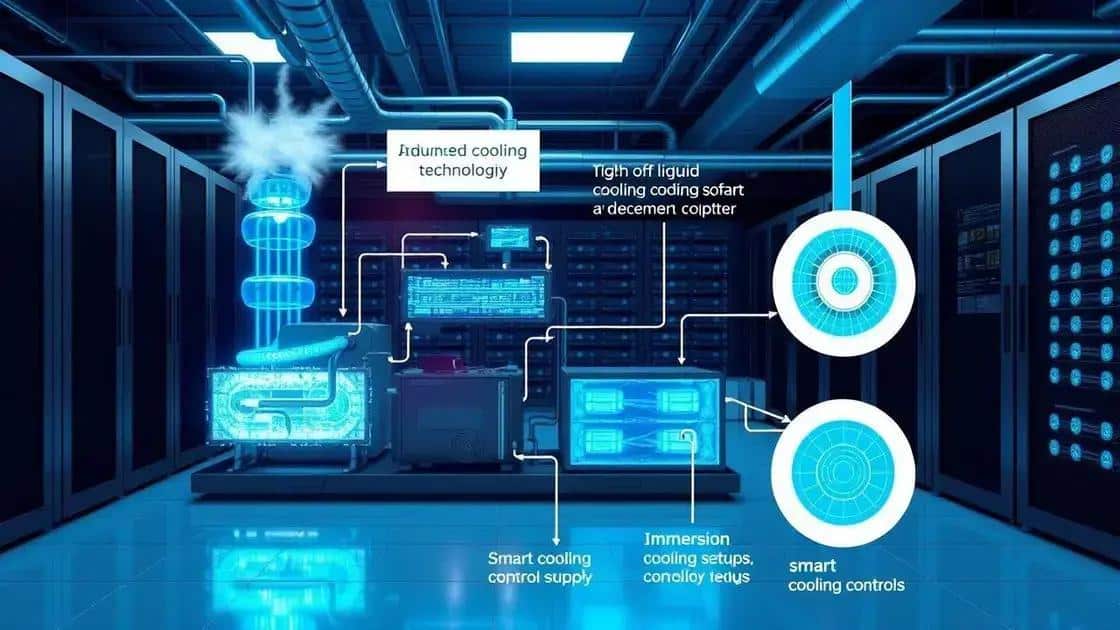
The latest advancements in cooling technologies play a crucial role in enhancing overall data center efficiency. As data centers grow in size and complexity, keeping hardware cool becomes a top priority. New innovations are making it easier and more efficient to manage temperatures.
Emerging Cooling Solutions
Several innovative cooling solutions have emerged recently:
- Liquid Cooling: This method uses liquid instead of air to cool servers, providing more effective heat removal.
- Immersion Cooling: In this technique, hardware is submerged in a thermally conductive liquid, which significantly reduces temperatures.
- Evaporative Cooling: This solution cools air through the evaporation of water, which is highly efficient and environmentally friendly.
Each of these methods offers unique benefits. For instance, liquid cooling can achieve greater cooling efficiency and lower energy costs compared to traditional methods. Furthermore, as energy efficiency becomes more critical, these advanced solutions are helping organizations reduce their carbon footprints.
Smart Cooling Systems
The integration of smart technologies in cooling systems is also a game-changer. Using artificial intelligence, data centers can optimize cooling based on real-time demands. This means that energy is used only when necessary, contributing to significant cost savings.
By continuously adapting to changes in temperature and server load, smart cooling systems ensure that servers remain within optimal operating conditions. This not only preserves equipment but also enhances overall performance.
Energy consumption trends in data centers
Energy consumption trends in data centers are vital for organizations looking to improve their efficiency. As technology evolves, understanding how data centers utilize energy can lead to significant cost savings and environmental benefits.
Current Trends in Energy Usage
Today, data centers consume a substantial amount of energy, often exceeding that of small cities. As companies increase their digital footprint, energy demands grow. Key trends to observe include:
- Increased Demand from Cloud Services: The rise of cloud computing has significantly increased energy needs as more organizations migrate their data and applications.
- Shift Towards Renewable Energy: Many data centers are now investing in renewable energy sources, aiming for sustainability and reduced carbon footprints.
- Energy Efficiency Improvements: With new technologies and smarter designs, data centers are becoming more efficient, thus reducing overall energy consumption.
By addressing these trends, organizations can better manage their energy usage and costs. For example, adopting sustainable energy solutions not only minimizes environmental impact but can also lead to regulatory benefits.
Monitoring and Optimizing Energy Use
To further enhance energy efficiency, data centers are increasingly implementing monitoring systems. These technologies provide real-time insights into energy consumption patterns. Understanding peak usage times and identifying energy hogs can help facilities deploy resources more wisely.
Incorporating smart technologies, such as AI and machine learning, allows for predictive analytics. This can lead to optimizing energy use based on demand, resulting in lower costs and improved overall effectiveness.
Best practices for optimizing performance
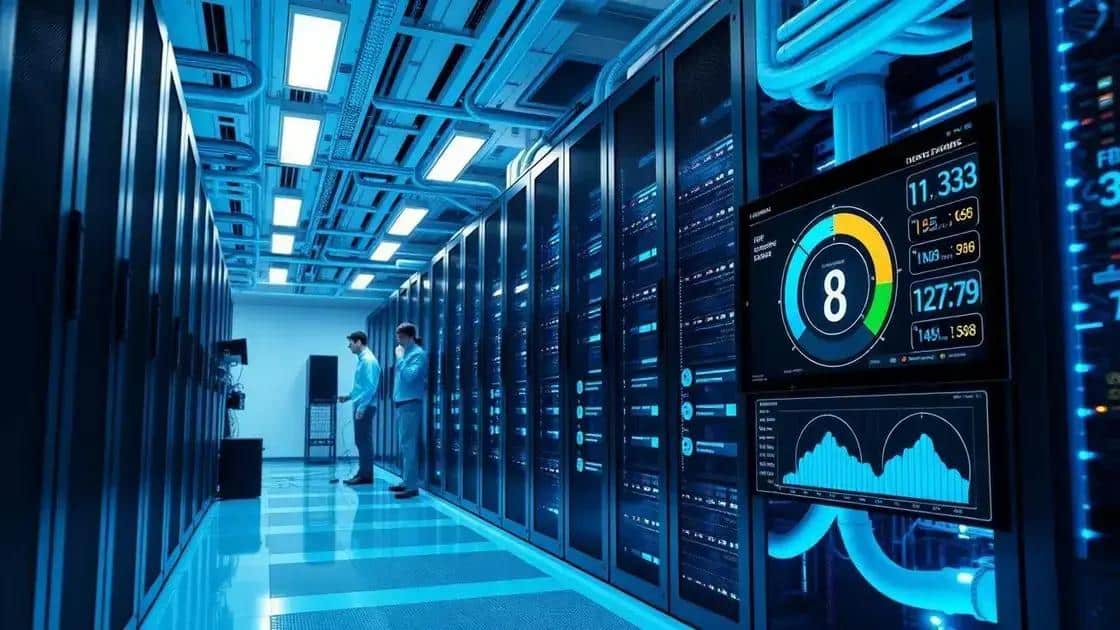
Best practices for optimizing performance in data centers are essential for effective resource management. By implementing these strategies, organizations can enhance their operational efficiency and reduce costs.
Regular Maintenance
One of the fundamental practices is conducting regular maintenance. Keeping hardware and software up to date ensures that technology runs smoothly. Additionally, maintenance helps prevent unexpected failures that could lead to downtime.
- Firmware updates: Regularly update firmware on all devices for better performance and security.
- Routine hardware checks: Regular inspections can identify potential issues before they become significant problems.
- Software optimization: Keeping software optimized is crucial for performance and security.
Implementing a scheduled maintenance plan allows data centers to function optimally while minimizing risks.
Effective Cooling Management
Cooling is another critical aspect of performance optimization. Proper cooling techniques can significantly improve efficiency. For instance, maintaining optimal temperatures for servers reduces energy consumption and prolongs equipment life.
Utilizing advanced cooling technologies such as liquid cooling or aisle containment can enhance cooling efficiency. By keeping temperatures stable, data centers can operate more effectively while reducing energy costs.
Energy Management Practices
Adopting energy management practices is vital for optimizing performance. Using smart monitoring systems helps track energy consumption in real-time. Organizations can analyze this data to identify inefficiencies and adjust strategies as needed.
Training staff to understand energy consumption patterns can also foster a culture of awareness and efficiency. Encouraging proactive measures, such as shutting down unused servers, can lead to substantial energy savings.
FAQ – Frequently Asked Questions about Data Center Optimization
What are the best practices for maintaining data center performance?
Best practices include regular maintenance, efficient cooling management, and implementing energy monitoring systems.
How does effective cooling impact data centers?
Effective cooling improves energy efficiency, reduces operational costs, and prolongs the life of hardware.
Why is energy management important for data centers?
Energy management helps reduce costs and minimize the environmental impact of data center operations.
What trends are influencing energy consumption in data centers?
Trends include increased demand from cloud services, a shift towards renewable energy, and advancements in energy-efficient technologies.
